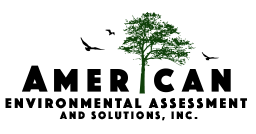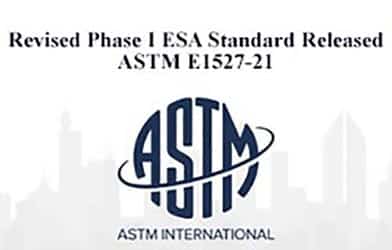Revised Phase I ESA Standard Released
ASTM-E1527-21
On November 1st, the American Society for Testing and Materials (ASTM) released a revised standard for conducting Phase I Environmental Site Assessments (Phase I ESAs). The new standard – ASTM E1527-21 – establishes new requirements for complying with the “All Appropriate Inquiry” (AAI) rule in 40 CFR Part 312. The AAI is an essential element of environmental due diligence used to protect prospective buyers, lenders, and owners from liability related to environmental contamination. E1527-21 will not be a required part of the AAI rule until the US EPA adopts it through a formal rulemaking. Nevertheless, those involved in environmental due diligence and transactions should start to become familiar with E1527-21 and begin to incorporate its requirements into Phase I ESAs.
While E1527-21 contains several changes from the prior ASTM standard for Phase I ESAs, these new additions are not as significant as those made the last time the standard was revised in 2013. The following provides a brief summary of several of the more noteworthy updates:
- The terms Recognized Environmental Condition (REC); Controlled Recognized Environmental Condition (CREC); and Historical Recognized Environmental Condition (HREC) have all been updated with important clarifications, including:
- Offsite issues without the potential to impact the subject property are now clearly excluded from the definition of REC;
- The Findings and Opinions section of a Phase I ESA must now include the rationale for finding a condition is a CREC or a HREC; and
- For each HREC, the environmental professional must also state whether the HREC still qualifies as an HREC.
- Definitions for “Property Use Limitation” and “Significant data gap” are now available.
- Emerging contaminants, such as PFAS, are now included on the list of non-scope items, at least until they are classified as a CERCLA hazardous substance. However, the non-scope issues appendix now includes a discussion of emerging contaminants and states that where the Phase I ESA is performed to satisfy both federal and state requirements the environmental professional should consider and discuss these substances if they are considered hazardous under applicable state law.
- The historical records review section now reflects common industry practice, including subject and adjoining property identification, use, and research objectives.
- Numerous updates and additions to the appendices, including a flowchart and guidance to help properly classify conditions as RECs, CRECs, or HRECs, a revised report outline, and a discussion of business environmental risks.
If a revised Phase I ESA ASTM standard was not enough reason to remind you of the importance of properly and timely conducted Phase I ESAs, then a recent decision from the U.S. Court of Appeals for the Seventh Circuit should help. In September, the Seventh Circuit affirmed the District Court’s finding that a party was not entitled to assert the bona fide prospective purchaser (BFPP) defense under CERCLA because the party’s Phase I ESAs did not comply with the AAI (Von Duprin LLC v. Major Holdings, LLC, No. 20-1711 (7th Cir. Sep. 3, 2021)).
The District Court had found that the environmental professional failed to make the required inquiries with the property owner and failed to include the necessary certifications in a Phase I ESA for one property. In connection with a second property, the court found that the Phase I ESA was completed within the appropriate timeframe (180 days) prior to the party’s purchase of the property, however the party started a 99-year lease of the same property six years prior to it purchasing the property. Thus, the party became an operator under CERCLA at the start of its lease and had not satisfied the AAI rule at that time because the Phase I ESA the party conducted prior to signing the lease was not completed or updated within the 180 days before the start of the lease, as required by the AAI rule.
All parties involved in commercial real estate transactions, including leases, should continue to familiarize themselves with the AAI rule and the newly revised ASTM standard (E1527-21). Complete and timely Phase I ESAs remain a staple of commercial real estate transactions. Failure to fully comply with the AAI can have long-lasting and significant consequences.
By Jon Schaefer on November 16th, 2021
Robinson+Cole’s Environmental Law





